

STAR TREK Modeling: A Brief History of the Shuttlecraft Galileo Pt. 5
Thank for returning for this final chapter in Round 2 consultant, Gary Kerr’s, history on the Galileo shuttle.
A Brief History of the Shuttlecraft Galileo Pt. 5 By Gary Kerr
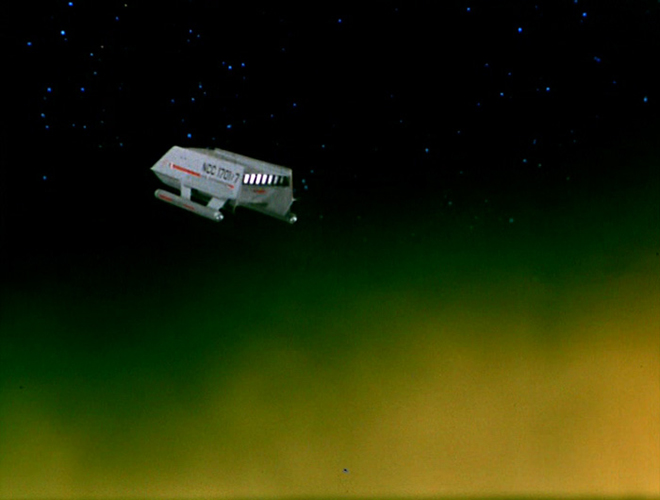
Rescue and Rebirth
The whereabouts of the Galileo were unknown, and fans despaired that it had been scrapped, but the plucky shuttlecraft resurfaced in 2012, when Kiko Auctioneers held an 11-day online auction. The auction price was holding at around $20,000, but on June 28, 2012, the bidding came to a head when three bidders jumped in during the last 90 seconds of the auction. Adam Schneider, a collector of numerous Star Trek studio miniatures, placed the winning bid of $70,150.00, and the Galileo became by far the largest spaceship model in his collection.
Since the Galileo was far too large to display at Adam’s home in New Jersey, Adam’s goal was to completely restore the rotting prop and donate it to a museum for public display. Gene Winfield, who had originally built the Galileo, suggested that a builder of wooden boats might be best suited for the job, and Adam selected Master Shipwrights Design and Restoration, which specialized in restoring antique and classic boats, to do the restoration. The Galileo was trucked to Master Shipwrights in Atlantic Highlands, NJ, but six days later, on October 29, 2012, disaster struck, as Hurricane Sandy slammed into the East Coast. In anticipation of a storm surge, the mock-up’s nacelles were placed in a high and dry location, while the mock-up, itself, sat on 12” blocks. Sandy’s storm surge flooded Master Shipwrights’ shop with four feet of water, but the Galileo survived. As Adam said, the mock-up was already such a hunk of junk that the floodwater couldn’t hurt it any further.
Over the next two months, the shop’s employees de-salted the shop and the mock-up, and then they went to work on the Galileo.
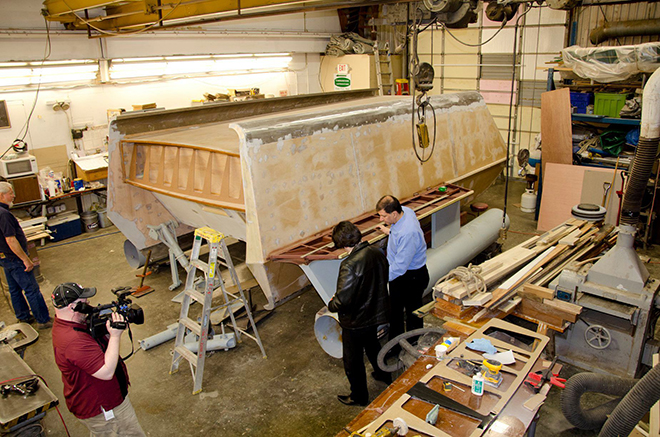
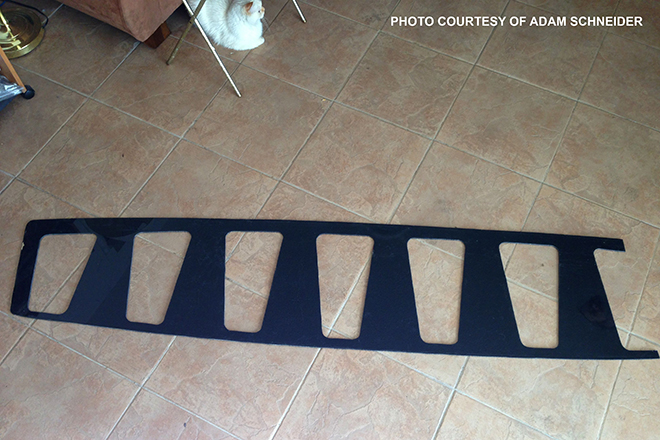
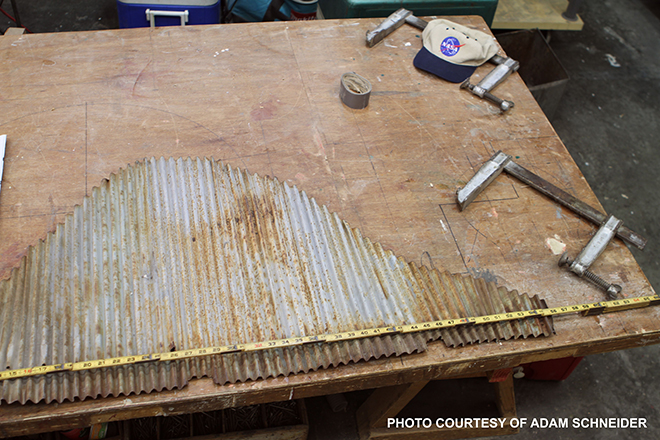
After they straightened and repaired the ship’s internal metal skeleton, they replaced the rotted framing with all-new wood. Lift points were added so the heavy mock-up could be moved safely. Sturdy Marine-grade plywood replaced the flimsy Masonite, and the finished shuttle was painted with marine-grade paint. I supplied artwork for the external markings, plus additional information, and Will Smith built a replacement “busy box”, a collection of gizmos hidden behind a fold-down panel on the aft end of the shuttle, which Spock and Scotty would work on every time the shuttle got stranded on an alien world.
Once the Galileo was fully restored, Adam set about finding a suitable museum to house the ship. Display space, especially for an artifact as large as the Galileo, is at a premium in most museums, and after contacting over a dozen museums, Adam settled on NASA‘s Space Center Houston, which is part of the Johnson Space Center. The Galileo was unveiled, amid much ceremony, on July 31, 2013.
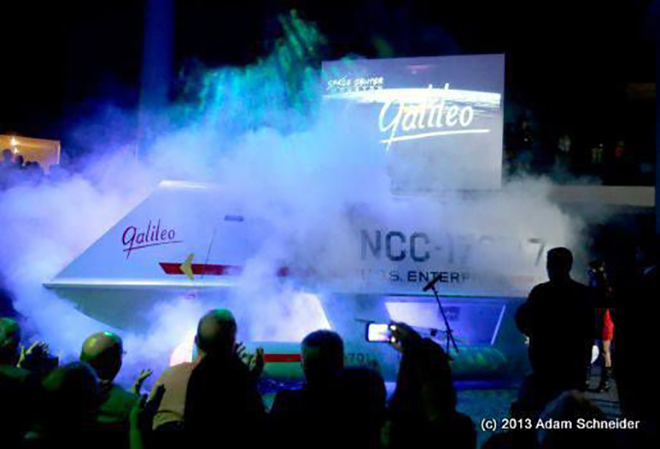
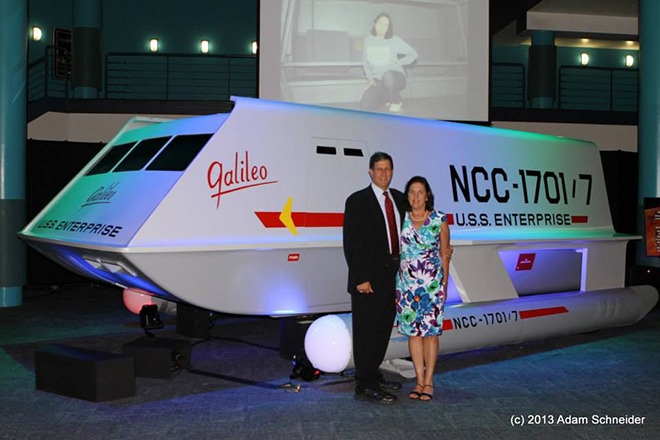
In 2016, the Galileo was loaned to the Intrepid Sea, Air & Space Museum in New York City, and upon its return to Houston, the shuttle was ignominiously displayed in a corner of the museum’s cafeteria.
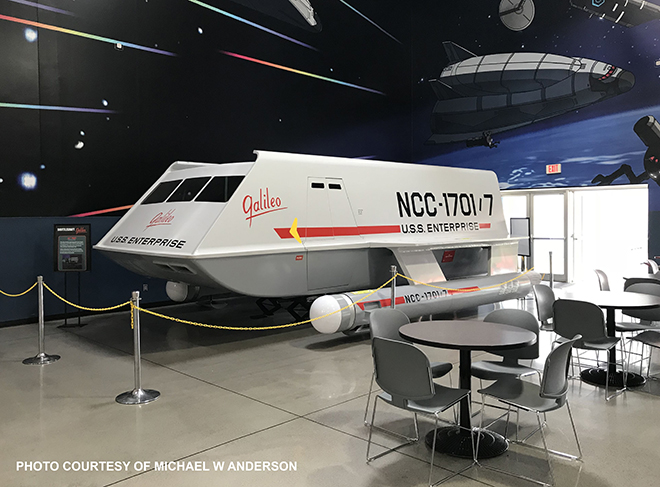
The current management team at the museum is apparently not a fan of Star Trek. The Galileo has been removed from public display and put into storage because it does not fit into management’s “vision” for the museum.
The Filming Miniature
In contrast to its widely-traveled big brother, the 22-inch Galileo miniature was a relative shut-in and remained in the Los Angeles area for most of its existence. The model, constructed mainly from wood and plastic, was designed to be filmed either suspended from wires, or mounted on a post inserted into the model’s belly. The studio model also had internal lighting for its impulse deck and front windows. Richard Datin had decal sheets with markings for both the Galileo and Columbus, but only the Galileo markings were ever applied to the model.
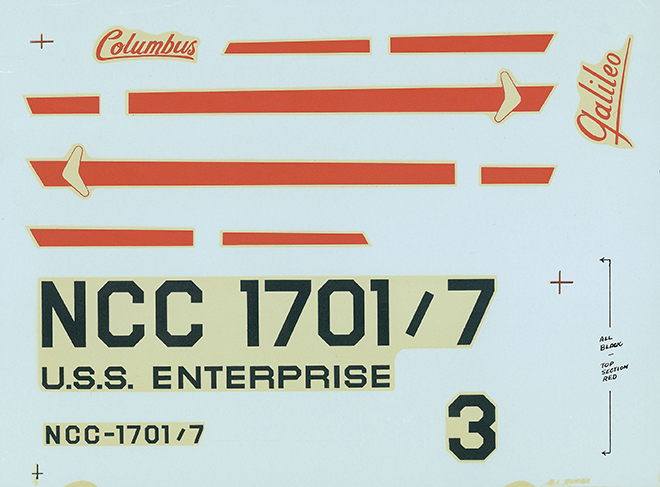
One of the model’s features has been overlooked until recently. In 2019, Star Trek authority, Doug Drexler, and aerospace historian and writer, Glen Swanson, had been sleuthing through the archives at UCLA and AMPAS (Academy of Motion Picture Arts and Sciences). Doug and Glen hit pay dirt, we were able to use Doug’s Academy Award winner discount to get 600 dpi scans of previously unreleased photographs (not grainy film clips) of the studio model of the Enterprise, plus shots of the newly built Galileo miniature before it was fully detailed. The model, suspended from overhead wires, had a glossy, 2-tone paint scheme, and apparently to serve as Commodore Mendez’s shuttle in “The Menagerie, Pt 1”, somebody had plastered “173” in large letters on the model’s side. Richard Datin worked on the model for several hours on October 31, 1966, and this may have been when the Galileo’s official markings were applied.
The most important discovery lay on the model’s wooden roof: the existence of scribed panels. They were very similar to the panels on the concept illustration that Thomas Kellogg had drawn for Gene Winfield and Matt Jefferies in 1966, when an affordable version of the Galileo was first being designed.
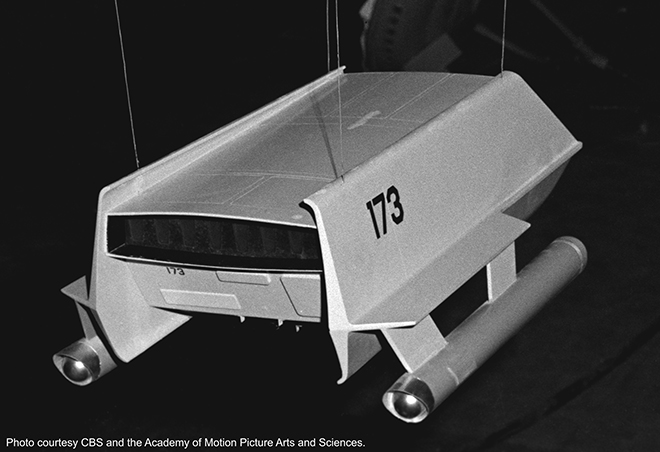
The 22-foot mock-up did not possess corresponding roof panels, which makes financial sense. Because the roof of the mock-up was seen only one time in the series, in a wide establishing shot in “The Galileo Seven”, it seems reasonable did not want to waste their budget dollars on full-size panels.
The model vanished after the series ended, and was presumed to be lost, stolen, or destroyed during a cleanup at Paramount in 1973. In 1987, though, the Galileo model unexpectedly reappeared. As long-time scenic art supervisor and Trek historian, Michael Okuda, explained, Set Decorator John Dwyer found the shuttlecraft miniature in storage at Paramount. He brought it up to the Art Department, plopped it onto Mike’s desk, and asked, “Do you know what this is?”
The Galileo was in pretty poor shape. The entire front bulkhead (the panel with the windows) was missing, and overall surface was cracked pretty badly. The nacelles, themselves, were broken off, and the corrugated cowlings on the ends of the nacelles were missing.
Dwyer took the model down to the effects shop to have it refurbished. They did a decent job, considering that they were undoubtedly rushed, and probably didn’t have any reference to work from, except the prop itself. The most significant error that they made was that the front panel, instead of being replaced with a new solid piece with three windows, was replaced with a single piece of dark Plexiglas “window”. The model also lost its 2-tone paint scheme.
Dwyer used the model as set dressing in Riker’s quarters in the 7th episode of the first season of Star Trek: The Next Generation, “Lonely Among Us“, which was filmed from August 26-September 3, 1987.
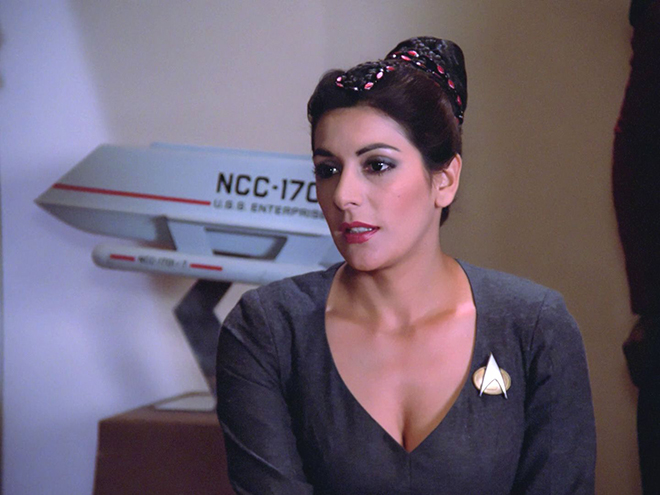
Early the following year, master model maker Greg Jein, who had begun to refurbish the model, loaned it to the local “Equicon ’88 Science Fiction Convention“, where it was on display from April 1-3, 1988.
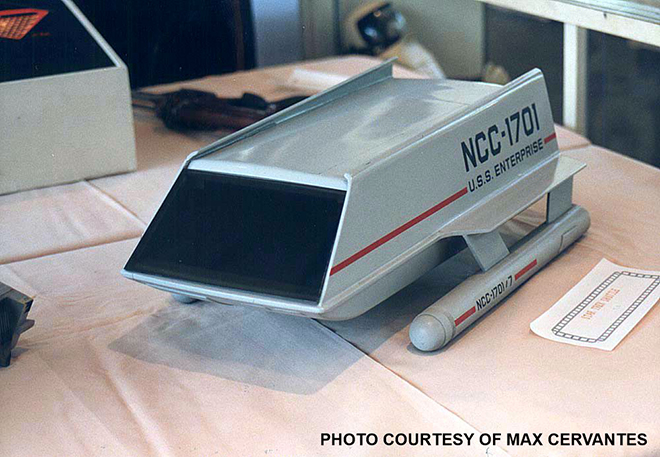
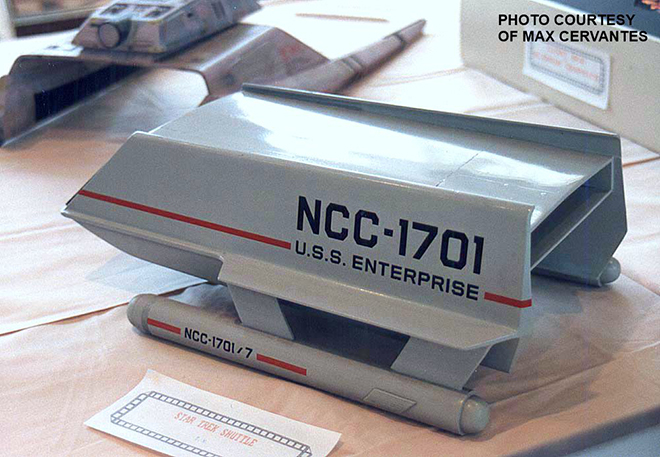
Afterwards, Greg Jein finished restoring the model to its original appearance, sans landing gear. Greg noted that before he restored the model, you could see straight through it, from front to back. During the restoration, Greg gave the model something that it had never had, a dash between the large “NCC” and “1701” on the side of the ship. The dash had accidentally been omitted from the 1966 decal sheet, and a quarter-century later, that oversight was remedied.
In 1992, Paramount loaned the Galileo model to the Smithsonian for their 1992-93 Star Trek exhibition.
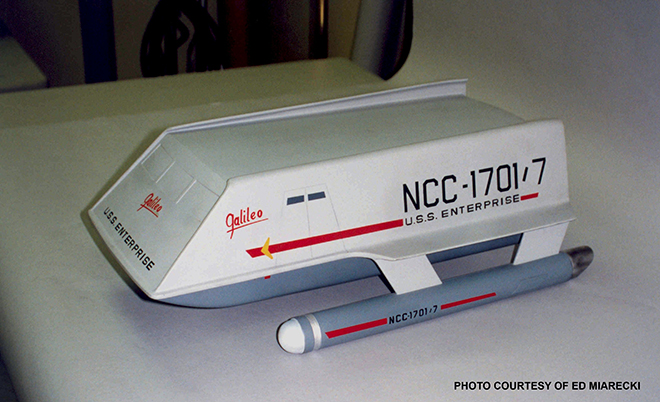
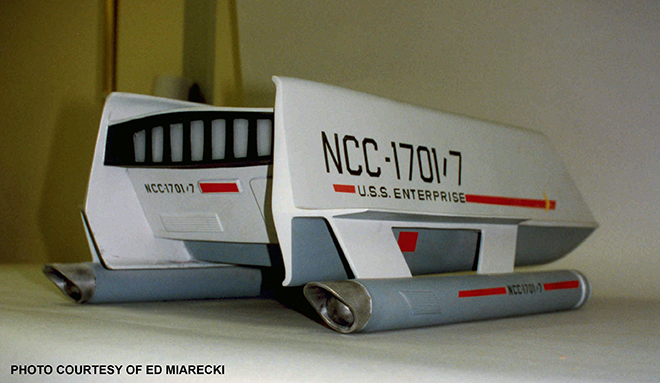
The model’s last public appearance was in 1993-94 at an exhibition at the Hayden Planetarium in New York City.
Epilog
Against all odds, both of the original Galileos have survived over 50 years of rain, sun, floods, crushing, and neglect. With any luck, they’ll be around for many more years to come.
Thank you, Gary, for all of the work you put into this special blog series. Until next time, live long and prosper!
All images courtesy of CBS, except where noted.
TM & (C) 2020 CBS Studios Inc. ARR.

This is fabulous! Thanks so much for this illuminating history. I can never get enough of this kind of stuff.
Thanks for this fascinating information on the Galileo props.
Question: I see the photo with Mr. Schneider and presumably his spouse. Note the landing pad orientation. Is that the intent? Seems that rotating it that way actually makes sense for flat ground. What do you think?
Hi jamie good to here you got alot of requests for the 1,1000 K’tinga hope you do it after the voyage can you reissue the AMT 1,650 and 1,1000 Klingon D7 again and do romulan decals with both kits from the animated series
I was at the restored shuttle’s unveiling Houston event in 2013. There were quite a few Trek and other sci-fi actors in attendance (Babylon 5, Buck Rogers, Dr. Who, to name a few) as there was a Sci-Fi convention happening in town around the same time. Also a bunch of ladies in TOS costumes. 😀
The full sized mockup was also used in an episode of the Star Trek Continues fan film series. They apparently filmed the scenes at Space Center Houston.
Disappointed to hear the current management has moved it out of public view as I always looked forward to seeing it there and would always point it out to people I took there.
Also, I kind of like the version with the black front, too.
Hi Jamie hope you will do the k,tinga 1,1000 in 2022 hope you are well happy new year
Hi jamie can you make a 1,350 TOS Romulan bird of prey is a 1,1000 k,tinga on the way
Hi jamie is the 1,1000 k’tinga on the way for new kits are you doing more reissue of star trek kits
HI Jamie for the star wars kit can you do a tie defender in 1,48 scale
Great article. Gary Kerr is famously meticulous in his research, but with this series he’s reached a new zenith. And PS, if I was Adam Schneider, I would take my donation of the Galileo back and give it to a museum that properly appreciates our beloved flying butter dish! >:(
Hi Jamie looking forward to wonderfest for star trek kits can you reissue the 1,1000 scale Klingon D7 battlecruiser and do Romulan decals again from the animated series and reissue the ANT D7 battlecruiser aswell
HI Jamie can you do the bounty hunter fighter from the mandalorian season 1 episode 5 the gunslinger in 1,72 to go with the razor crest and for star trek can you reissue the 1,1000 klingon D7 and AMT 1,650 one as well and do romulan decals with them from the animated series and hope in 2022 is the 1,1000 scale klingon k.tinga
In re: Jefferies’ Aug 15, 1966 Galileo inspection airfare, I plugged his cost of $54.29 into an online inflation calculator and got $730.80. Then I googled “LA/Phoenix airfare” and found Southwest Airlines offering one-half tickets for $49.
Mr. Kerr, my greatest thanks for your article. Same to you guys for printing it…and ABOVE ALL, for you wonderful 1/32 Galileo.
Incidentally, my “stone knives and bearskins” fitting of the inside set into an embiggened outside is archived online, and easily findable. Had I done a revised draft, I’d have given her an inner hull, so’s not to widen the interior to match the fuselage’s overall width.
David Winfrey